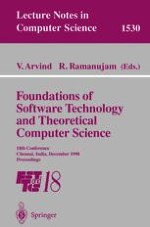1998 | Buch
Foundations of Software Technology and Theoretical Computer Science
18th Conference, Chennai, India, December 17-19, 1998. Proceedings
herausgegeben von: Vikraman Arvind, Sundar Ramanujam
Verlag: Springer Berlin Heidelberg
Buchreihe : Lecture Notes in Computer Science
Enthalten in: Professional Book Archive
